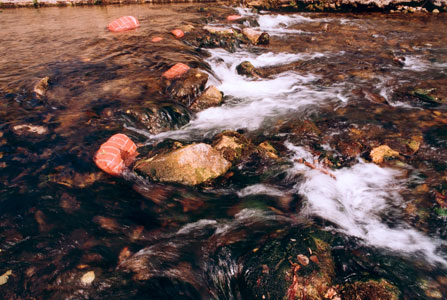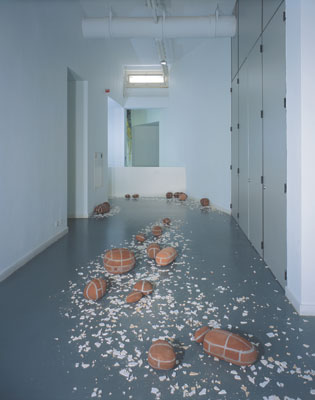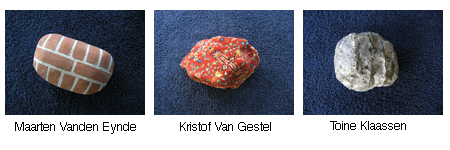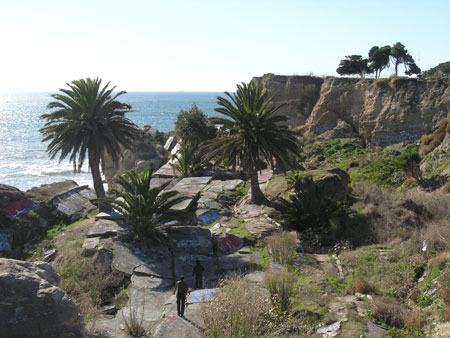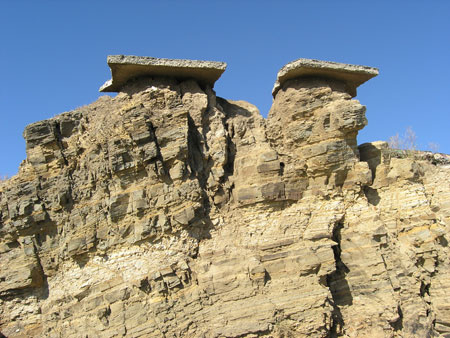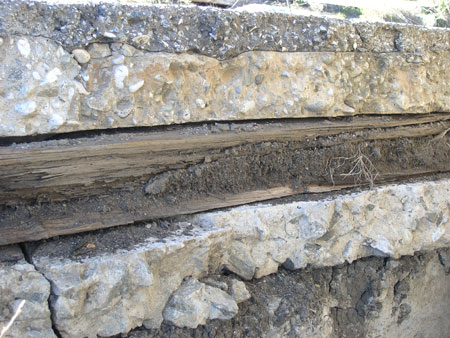The Origin and Development of Life on Earth
februari 2nd, 20061. The Uniformity of Life
Charles Darwin (1809-1882) was one of the first who saw the uniformity in all living organisms. He did extensive research on plants and animals and found so many comparability’s in structure and chemical composition that he came to the following conclusion: ‘probably all the organic beings which have ever lived on this earth have descended from some one primordial form (oervorm)’
Right now we know that this uniformity of life originates from DNA (DeoxyriboNucleid Acid) which can be found in the core of every cell. Certain parts of this DNA is copied into the messenger-RNA (RiboNucleic Acid). This copy leaves the cell-core into the cell-liquid to be transformed into endosperms. This is the central dogma of Biology.
The hereditary material from humans consists of +/- three billion construction toes (bouwstenen); the total length of DNA in every cell is about two meters. A cell is about hundred micrometer big and the core is just a small part of it. In order to store two meters of DNA in the cell-core, the DNA is folded compactly into chromosomes with the aid of some endosperms. Each of the 23 pair of chromosomes that we all have in every cell-core, exists of one long folded up DNA-molecule. To get an idea of the the incredible density: if you take all the DNA from all our chromosomes from all our bobycells, you can make a line which is one hundred times the distance from the earth to the sun.
The amazing part is that all this DNA originates from an original DNA string of two meters, of which we all started when we were conceived.
Now the question is which is the most recent common descendant of all plants, animals, moulds and micro-organisms that ever lived on this planet?
What was it? When did it live? And where did it come from?
2. From Soup to Pizza.
RNA is a barrier of hereditary information, but can also influence molecules. RNA is just like DNA a string of nucleine sour. It is build up out of sugar, phosphate and nitrogen bases, but consists usually of one string. DNA has two. RNA arises more easy than DNA, it is extremely flexible and occurs in different qualities. Some forms of RNA have functions, just like some endosperms, which can accelerate a chemical reaction: so called ‘catalytic functions’. Basically RNA can preform both functions of DNA and Endosperms. Therefor RNA can be the chicken and the egg at the same time.
To make molecules, like RNA- molecules, you need to have atoms. The basis material for the creation of life is given by nucleo synthesis, the forming of new atoms. This occurred during core fusion processes, just after the Big Bang, and during the formation of new stars.
With many different atoms a chemical evolution can take place. But in order to start this process the atoms need to be put together. This could have happened by the impact of meteorites, who could have delivered simple organic connections.
It is generally believed that a comet consists basically of a loose conglomeration of frozen gases with embedded material similar to that found in the carbonaceous chondritic meteorites, and consequently that comets may be nearly pristine samples of the original solar nebula1−5. Thermal processing within comets could have played an important part in determining their present state; in particular, we find that liquid water might have been available in some comets over geologically and biologically significant spans of time. It follows that a cometary origin is not excluded for some thermally metamorphosed meteorites and asteroids, that comets may contain quite complex organic molecules, and that comets may have played a role in the origin and conceivably even in the subsequent evolution of terrestrial life.
It could also have taken place under the crust of the earth, deep under the oceans. By shifting the tectonic plates the atoms could have gone to the surface and started to make molecules. In the classical ‘prebiotic soup’ model of the origin of life, biomolecules are seen arising abiotically on the Earth and then interacting randomly in solution to form proto-cells. This model has encountered increasing difficulties, however, and recently several alternatives have been proposed. In some of these models, it is postulated that proto-cells evolved from simple biomolecular complexes originally attached to mineral surfaces, especially those of pyrite. The subsequent evolution of these complexes has been likened to embryonic development. Pyrite is a connection of sulphur and iron which were always abundantly present on earth. All chemical reactions necessary to create endosperms from simple anorganic molecules, can take place on the surface of pyrite. Here the ‘soup’ becomes a ‘primitive pizza’.
An alternative theory is the one of clay particles. The involvement of clay surfaces in the origin of the first genetic molecules on Earth has long been suggested. However, the formation of these polymers was not sufficient by itself to initiate the evolutionary process leading to the appearance of life. These macromolecules had to persist in primeval habitats so that their biological potentiality could be expressed. So maybe both theories intertwine somehow. Pyrite could provide the necessary atoms and create a basis where the process can occur, and clay particles could provide the cover for hazardous influences from the outside. Since there was no ozone layer at that time the deadly UV radiation killed any possible life on earth.
These findings indicate that primordial genetic molecules adsorbed on clay minerals would have been protected against degrading agents present in the environment and would have been in the right conditions to undergo evolutionary processes.
First came single-celled organisms, bacteria, that lived mostly in mud and water until they did something that radically changed the earth: they produced their food through photosynthesis. Cells could now remove carbon dioxide from the atmosphere and with the help of sunlight combine it with water to make sugars. This was a major breakthrough for life on earth: the waste product of this photosynthetic reaction is oxygen.
Restauration du Lac de Montbel, 2003
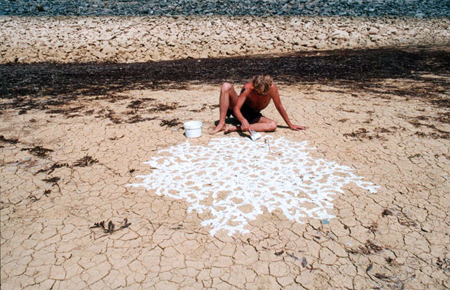
Maarten Vanden Eynde
In 2003 I went to France to restore a dried out lake near the city of Montbel. The bottom is clay and dries out more and more every year. The white restoration paste is plaster. The work existed only temporary and was destroyed in spring, when new water came and filled up the lake again.


